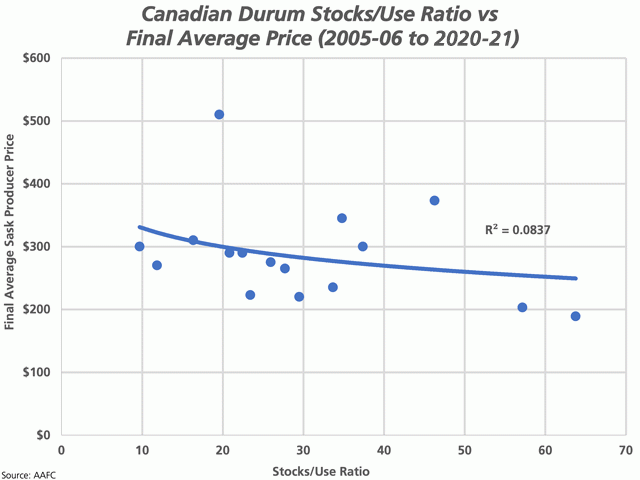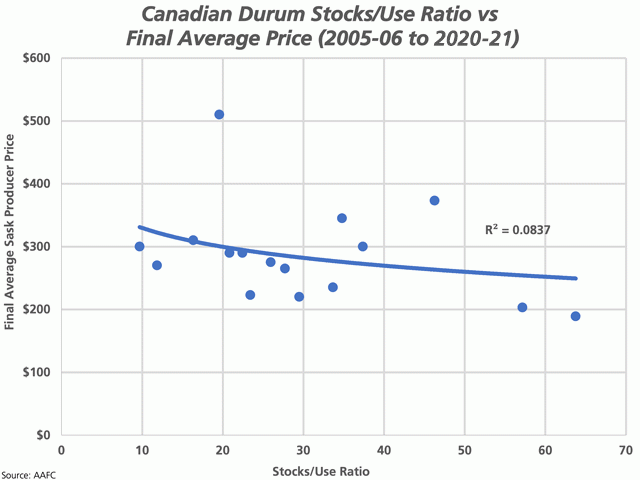Canada Markets
A Look at Current Signals in the Durum Market
The most recent Canada: Outlook for Principal Field Crops released by Agriculture and Agri-Food Canada (AAFC) in June quotes International Grains Council data that shows increases in durum production in Europe and North Africa to offset reductions in North America in 2021-22. Global ending stocks are forecast to grow by 400,000 metric tons to 8.5 million metric tons. The average price received by Saskatchewan farmers in 2021-22 was forecast to fall by $30/mt to $270/mt.
As of the end of June, the latest crop condition for Saskatchewan is shown at 45% good to excellent, which compares to the five-year average for this week of 65%, while the lowest since 2015. As of June 28, the Alberta government rated its crop at 48.2% G/E. Further deterioration has been seen since, with a record-setting heat wave hitting the Prairies during the week of June 28.
As of July 4, the USDA estimated the North Dakota crop condition at 47% G/E, which compares to the five-year average of 66.2%. The Montana crop was estimated at 40% G/E, equal to the five-year average for the week.
Continued above-average temperatures and lack of rainfall will lead to ongoing pressure on the ratings and overall crop potential, perhaps even abandonment in some areas.
P[L1] D[0x0] M[300x250] OOP[F] ADUNIT[] T[]
North American durum prices are on the move higher. DTN's National Durum Index reached a high of $8.04/bushel USD this week, while reported at $8.02/bushels (bu) on July 8. This follows a steady climb from a low of $5.24/bu in September 2020, while is at the highest levels seen since July 2017 when a high of $8.17/bu was reached.
Bids across the southern Prairies reported by pdqinfo on July 8 were shown to range from $328.62/metric ton CAD in southern Alberta to $338.30/mt in western Manitoba, after a jump as much as $5.85/mt was seen in southeast Saskatchewan. Bids by region shows the southern Alberta bid $7.97/mt from reaching its highest pdqinfo bid since data was started in September 2015, while the western Manitoba is $2.85/mt away from its high. Bids for southeast and southwest Saskatchewan have reached their highest level reported since September 2015 when this data was first released.
Next, we turn to Europe and Morocco where bigger crops are expected by the IGC. This could very well be the case in Morrocco. A June 28 USDA Grain and Feed attache report for Morocco estimates that country's wheat and barley production up 206% from last year, while at 9.8 mmt, is 26.3% above its 10-year average, which includes 2.4 mmt of durum. The government must feel confident in its supplies, with this report showing a hike in the country's import duty on common durum wheat from 0 percent to 170% as of May 15.
Europe's recovery in production could prove to be a different situation. On June 24, the European Commission estimated its durum crop at 7.817 mmt for 2021, up from 7.223 mmt in 2020. This is still below its reported trimmed five-year average of 8.350 mmt (calculated by removing the year with the highest and lowest production and averaging the remaining three years). When a simple average is calculated, this volume is 6.8% below the five-year average and 5.9% below the EU's 10-year average level of production.
While harvest should be taking place in southern areas of Europe, weekly price data reported by the EU shows the price for durum in Bologna, Italy increasing by EUR 6/mt as of July 8 to EUR 299, which matches the level reached in May, while weekly highs over the past year show prices reaching EUR 299/mt to EUR 301/mt in late November/early December.
The attached chart shows 15 years of AAFC's reported average price received by Saskatchewan producers (2005-06 to 2020-21) and their latest forecast for 2020-21, plotted against the stocks/use ratio for the crop year. While Canada is the largest durum exporter in the global market, this chart signals the link between Canada's stocks/use ratio and price received is a weak one.
Moving across the X axis, the third-highest stocks/use ratio of 46.3% in 2008-09 resulted in the second-highest average price seen over this period at $373/mt. As well, the highest average price during this period of $510/mt in 2007-08 was achieved when the stocks/use ratio was much higher than it is today at 19.6%. The first dot plotted as you move right across the horizontal axis is for the current crop year, an average of $300/mt with stocks/use at 9.7%, the lowest seen over this period.
Cliff Jamieson can be reached at cliff.jamieson@dtn.com
Follow him on Twitter @Cliff Jamieson
(c) Copyright 2021 DTN, LLC. All rights reserved.





Comments
To comment, please Log In or Join our Community .